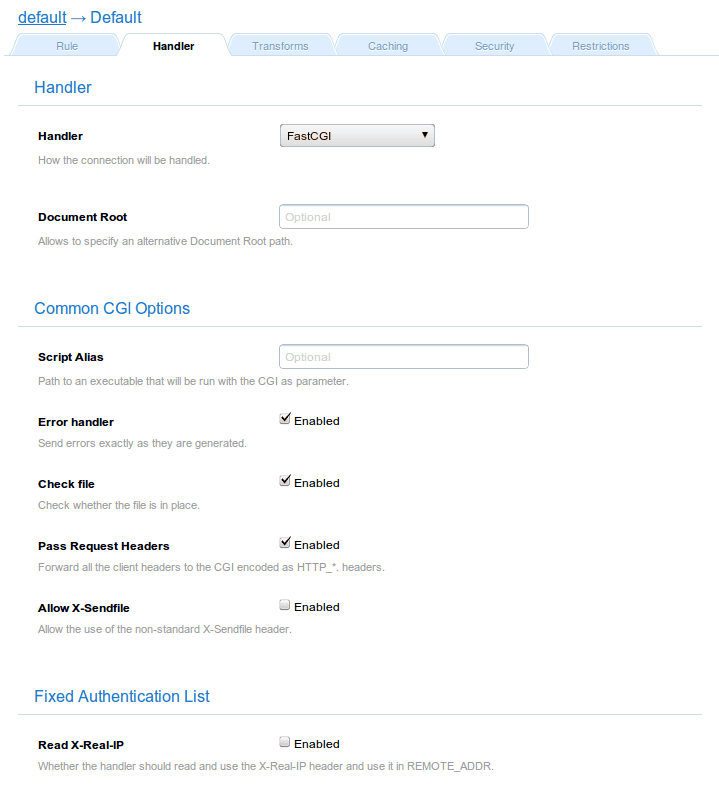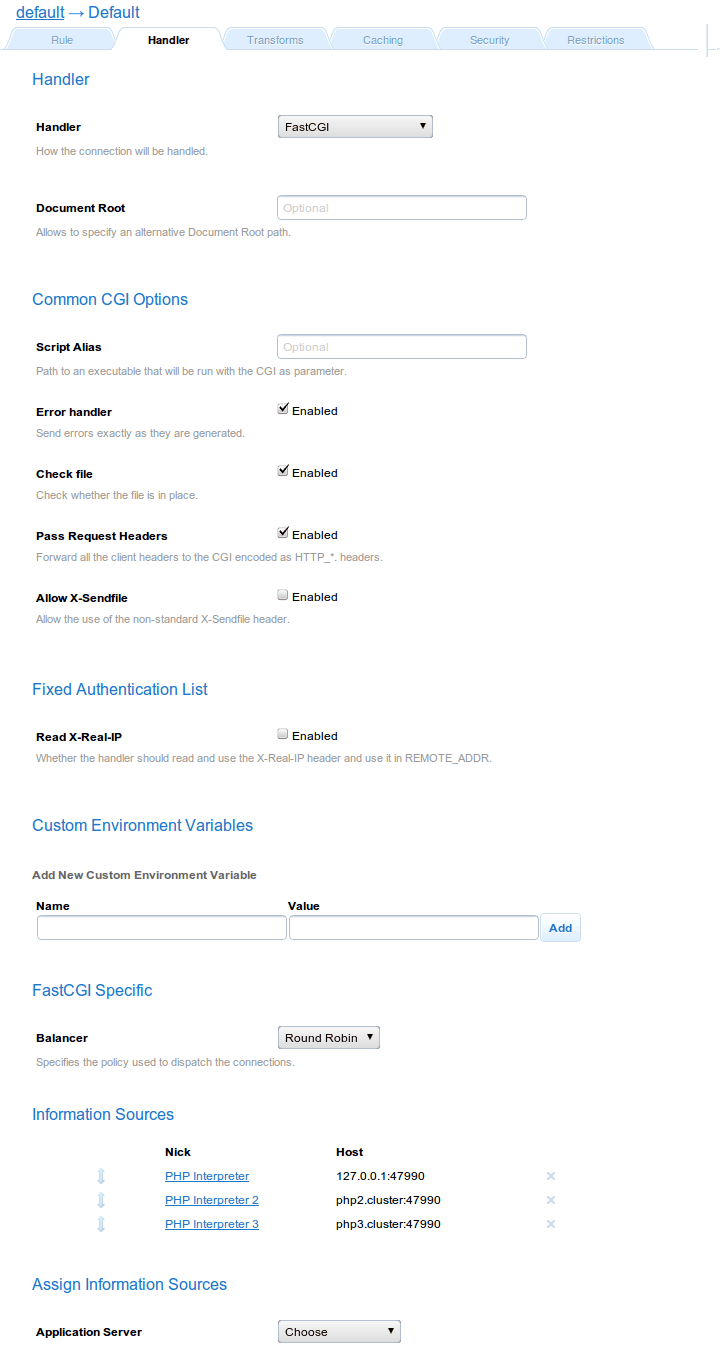
Documentation
Cookbook: Setting up PHP
There is not much to learn to configure PHP with Cherokee. Cherokee-admin ships a one-click wizard that will do everything for you. It will look for the PHP interpreter, it will check whether it support FastCGI, and then it’ll perform all the necessary operations to set it up on Cherokee. It is a piece of cake.
If PHP-fpm binaries are found, those will be prioritized over the regular binaries.
There is also a screencast available at the Cherokee-Project website to demonstrate how easy it is to use the PHP wizard.
It requires a single operation to get PHP configured on a pre-existing Virtual Server: Choose the virtual server your want to configure, and click on the Behavior tab and trigger the Rule panel by clicking on the Rule Management button. Once in there, use the Add button at the top of the panel to see the available wizards.

Now select Languages and run the PHP wizard. And, that’s it. If you had php-fpm or php-cgi installed in your system, PHP should be configured now.
PHP FastCGI support
Note that only FastCGI-enabled binaries of PHP will work with the FastCGI handler. Many prepackaged versions already enable this by default. If yours does not, you will need to build a suitable binary. You can check this with the -v parameter:
$ php-cgi -v PHP 5.2.10 (cgi-fcgi) (built: Jul 11 2009 15:33:11) Copyright (c) 1997-2009 The PHP Group Zend Engine v2.2.0, Copyright (c) 1998-2009 Zend Technologies
You cannot proceed unless the "cgi-fcgi" string is present.
PHP process Environment Variables
To specify Environment Variables at the Information Source level be sure to uncheck Inherit Environment. This will display the form to enter variables and values.
The PHP_FCGI_CHILDREN environment variable is mandatory for PHP FastCGI servers. It defines how much children should serve the requests coming from the webserver.
If you define PHP_FCGI_MAX_REQUESTS, the value must be negative if you do not want the PHP process to ever be restarted. If you leave it unset, PHP will take the default value (500), after which it will be restarted. It is generally a good idea to let PHP be restarted to free up resources and possible memory leaks.
Advanced configuration
Once PHP is configured, you are free to tweak the configuration to adapt it to your specific needs. You may want to change some of the php-cgi parameters, or even point Cherokee to use distributed PHP execution.
This example shows a typical usage of FastCGI. It only uses one information source nicknamed php in this case. This connects to a FastCGI server located in localhost in port 47990. If no server is running, the webserver will run the FastCGI server by issuing the command defined as the Interpreter sub-parameter of the information source that is being accessed.

| Checkbox | Value |
|---|---|
Error Handler |
Checked |
Check file |
Checked |
Pass request |
Checked |
Allow XSendfile |
Unchecked |
This other example shows a typical usage of multiple FastCGI servers. It connects to FastCGI servers in several locations. If no server is running in the local computer, the webserver will run the FastCGI server by issuing the specified command. Note that for remote FastCGI servers, you are responsible for running the FastCGI services there manually.

| Nick | Host |
|---|---|
PHP interpreter |
localhost:47990 |
PHP interpreter 2 |
php2.cluster:47990 |
PHP interpreter 3 |
php3.cluster:47990 |
Multi-site support
An even more advanced scenario would be one that required custom PHP settings for each virtual host.
In such a scenario several information sources are required. Some settings can be set simply by providing ENV variables to customize the FastCGI behavior. Others can only be specified in the php.ini configuration file, which is read by php-cgi on start-up.
The location of this file is platform dependent, so you will need to refer to PHP’s documentation. It is the file located in /etc/php5/cgi/php.ini on Debian/Ubuntu systems, /opt/local/etc/php5/php.ini on MacPorts, etc.
PHP configuration file
You will have to customize and specify different php.ini files for each information source. A nifty trick to do this and provide custom environment variables is by wrapping the required parameters in a simple script such as this one:
#!/bin/sh export PHP_FCGI_MAX_REQUESTS=250 export PHP_FCGI_CHILDREN=4 exec /usr/local/bin/php-cgi $@ # EOF
It just calls the real php-cgi with the ENV variables to customize the FastCGI behavior, passing the parameters along. The same wrapper can be used for every information source, providing a different -c path/php.ini for each one of them.
Bare in mind that every information source will need its own port to run.
Assuming that two customized information sources were required, simply specifying different interpreters for each one of them would suffice.
| VHost | Interpreter |
|---|---|
1 |
/usr/local/bin/php-cgi -c /usr/local/etc/php/php-vhost1.ini -b 127.0.0.1:2998 |
2 |
/usr/local/bin/php-cgi -c /usr/local/etc/php/php-vhost2.ini -b 127.0.0.1:2999 |
This, in turn, would produce configuration entries similar to the following ones:
source!1!nick = php-vhost1 source!1!interpreter = /usr/local/bin/php-cgi -c /usr/local/etc/php/php-vhost1.ini -b 127.0.0.1:2998 ... source!2!nick = php-vhost2 source!2!interpreter = /usr/local/bin/php-cgi -c /usr/local/etc/php/php-vhost2.ini -b 127.0.0.1:2999
PHP configuration variables
The variables specified in php.ini can also be overridden setting a custom environment variable on a per-virtual-server basis.
Just access the PHP rule of your virtual server, Extensions php, and select the Handler tab to be able to set a custom environment variable for the FastCGI handler.
You will need to provide the values in the following format:
| Name | Value |
|---|---|
PHP_ADMIN_VALUE |
memory_limit=128M |
This will set the memory limit for the virtual server only. Any php.ini variable can be set using this procedure.
Also, it is possible to manually specify every php.ini as a parameter of the interpreter thanks to the -d argument of PHP. Assuming you had to separate virtual servers, each with its own PHP information source, you could customize each of them directly editing the information source. This example would specify different memory limits for both information sources.
| VHost | Interpreter |
|---|---|
1 |
/usr/local/bin/php-cgi -d memory_limit=256M -b 127.0.0.1:2998 |
2 |
/usr/local/bin/php-cgi -d memory_limit=32M -b 127.0.0.1:2999 |
PHP upload limits
Every now and then this issue pops up: an HTTP error 400 appears repeatedly when uploading files to a PHP back-end.
PHP has several limits in-place which can be configured through its php.ini configuration file.
Two entries are related to this issue. Tweak them according to your necessities. In this example, we are rising the limit to 200MB.
; Maximum size of POST data that PHP will accept. post_max_size = 200M ; Maximum allowed size for uploaded files. upload_max_filesize = 200M

